Evaluating Hypertension, Stroke History & Bleeding in Warfarin Therapy
VerifiedAdded on 2023/01/19
|8
|1297
|34
Journal and Reflective Writing
AI Summary
This journal-style assignment investigates the relationship between hypertension, a history of stroke, and bleeding, particularly in patients undergoing Warfarin therapy. The study utilizes secondary data from 109 respondents of different age groups and employs statistical methods such as regression analysis and t-tests to analyze the data. The primary aim is to evaluate the key issues faced by patients undergoing Warfarin therapy and to explain the relationships between hypertension, stroke history, and bleeding. The findings suggest a least dependency level between hypertension, stroke, and bleeding, with the p-value indicating that stroke history is not statistically associated with hypertension. However, the t-test reveals a significant difference in bleeding before and after Warfarin therapy. The conclusion highlights that Warfarin therapy can lead to GI bleeding, and Aspirin is suggested to mitigate pain. The study concludes that hypertension and stroke are not statistically associated with each other, but there is a significant difference in the history of bleeding before and after Warfarin therapy. The document provides a detailed analysis and interpretation of the data.

Journal Style Writing
Paraphrase This Document
Need a fresh take? Get an instant paraphrase of this document with our AI Paraphraser
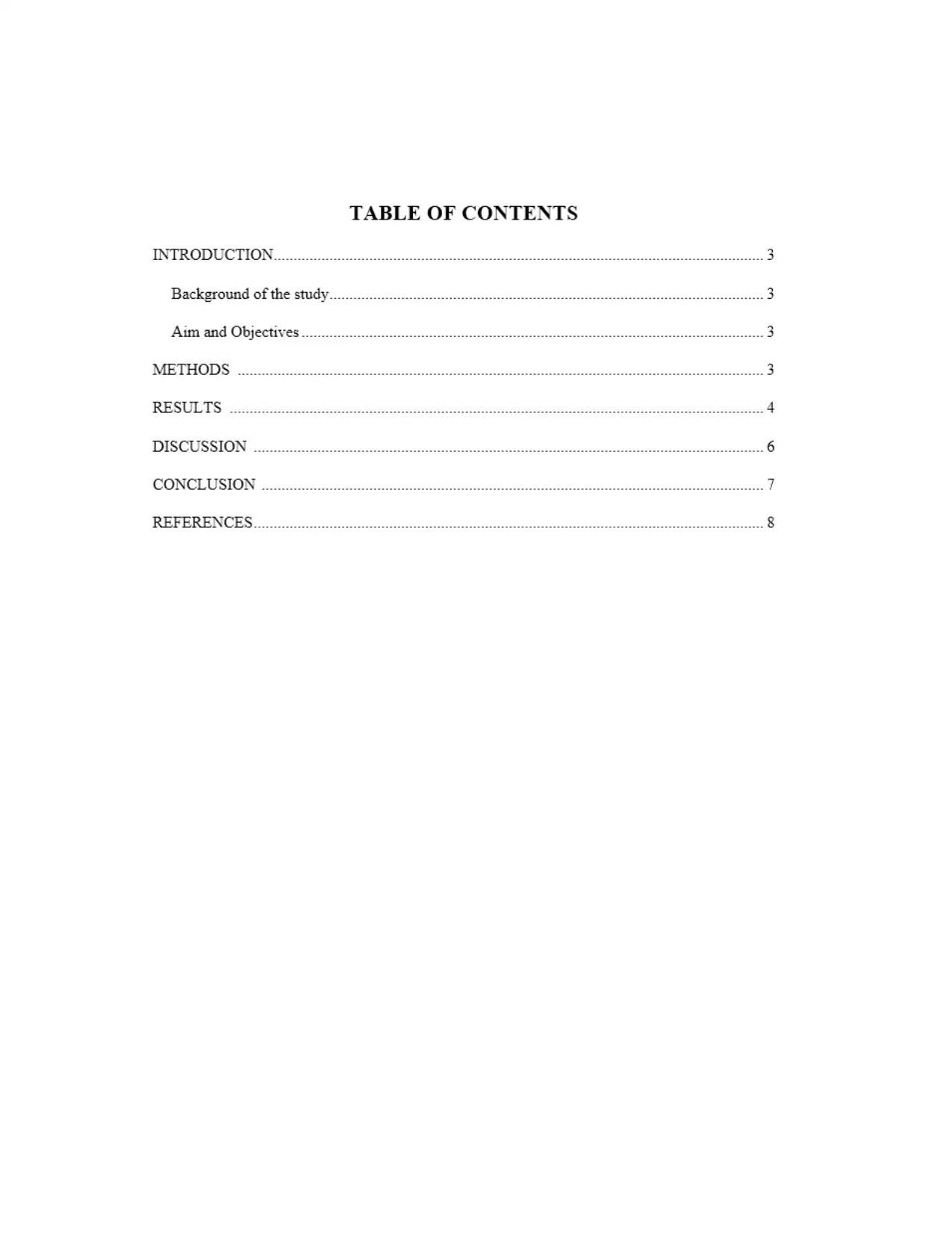
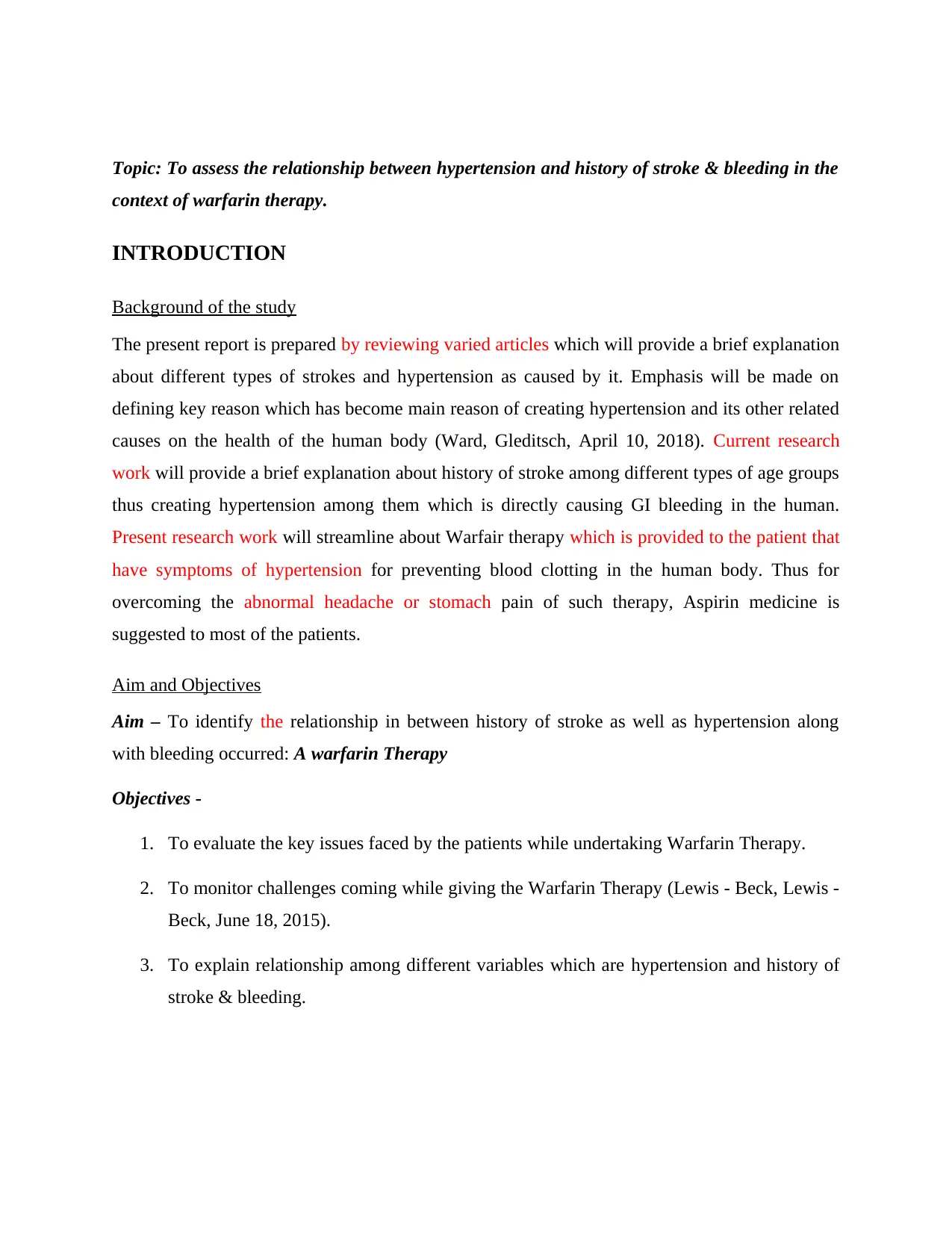
Topic: To assess the relationship between hypertension and history of stroke & bleeding in the
context of warfarin therapy.
INTRODUCTION
Background of the study
The present report is prepared by reviewing varied articles which will provide a brief explanation
about different types of strokes and hypertension as caused by it. Emphasis will be made on
defining key reason which has become main reason of creating hypertension and its other related
causes on the health of the human body (Ward, Gleditsch, April 10, 2018). Current research
work will provide a brief explanation about history of stroke among different types of age groups
thus creating hypertension among them which is directly causing GI bleeding in the human.
Present research work will streamline about Warfair therapy which is provided to the patient that
have symptoms of hypertension for preventing blood clotting in the human body. Thus for
overcoming the abnormal headache or stomach pain of such therapy, Aspirin medicine is
suggested to most of the patients.
Aim and Objectives
Aim – To identify the relationship in between history of stroke as well as hypertension along
with bleeding occurred: A warfarin Therapy
Objectives -
1. To evaluate the key issues faced by the patients while undertaking Warfarin Therapy.
2. To monitor challenges coming while giving the Warfarin Therapy (Lewis - Beck, Lewis -
Beck, June 18, 2015).
3. To explain relationship among different variables which are hypertension and history of
stroke & bleeding.
context of warfarin therapy.
INTRODUCTION
Background of the study
The present report is prepared by reviewing varied articles which will provide a brief explanation
about different types of strokes and hypertension as caused by it. Emphasis will be made on
defining key reason which has become main reason of creating hypertension and its other related
causes on the health of the human body (Ward, Gleditsch, April 10, 2018). Current research
work will provide a brief explanation about history of stroke among different types of age groups
thus creating hypertension among them which is directly causing GI bleeding in the human.
Present research work will streamline about Warfair therapy which is provided to the patient that
have symptoms of hypertension for preventing blood clotting in the human body. Thus for
overcoming the abnormal headache or stomach pain of such therapy, Aspirin medicine is
suggested to most of the patients.
Aim and Objectives
Aim – To identify the relationship in between history of stroke as well as hypertension along
with bleeding occurred: A warfarin Therapy
Objectives -
1. To evaluate the key issues faced by the patients while undertaking Warfarin Therapy.
2. To monitor challenges coming while giving the Warfarin Therapy (Lewis - Beck, Lewis -
Beck, June 18, 2015).
3. To explain relationship among different variables which are hypertension and history of
stroke & bleeding.
⊘ This is a preview!⊘
Do you want full access?
Subscribe today to unlock all pages.

Trusted by 1+ million students worldwide
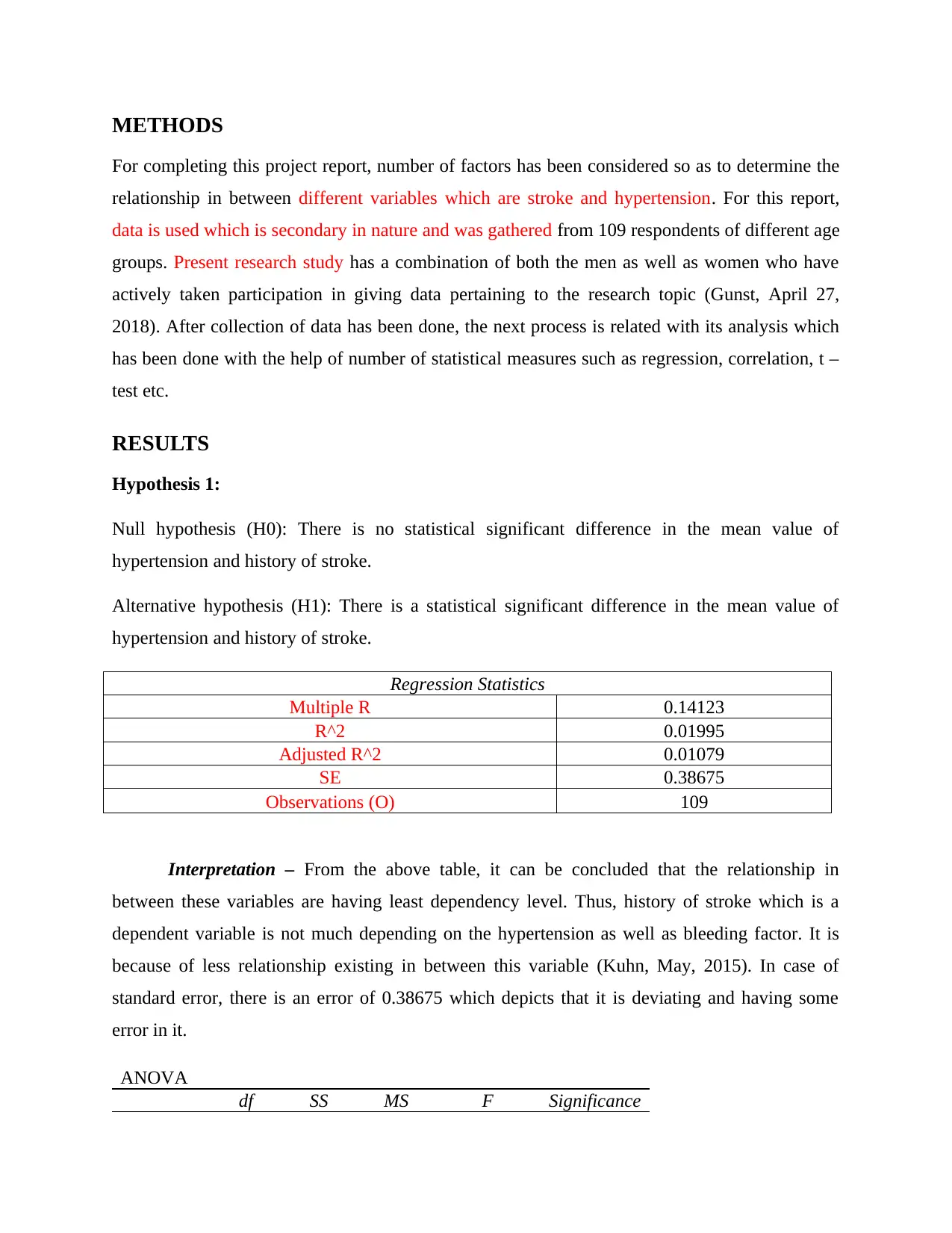
METHODS
For completing this project report, number of factors has been considered so as to determine the
relationship in between different variables which are stroke and hypertension. For this report,
data is used which is secondary in nature and was gathered from 109 respondents of different age
groups. Present research study has a combination of both the men as well as women who have
actively taken participation in giving data pertaining to the research topic (Gunst, April 27,
2018). After collection of data has been done, the next process is related with its analysis which
has been done with the help of number of statistical measures such as regression, correlation, t –
test etc.
RESULTS
Hypothesis 1:
Null hypothesis (H0): There is no statistical significant difference in the mean value of
hypertension and history of stroke.
Alternative hypothesis (H1): There is a statistical significant difference in the mean value of
hypertension and history of stroke.
Regression Statistics
Multiple R 0.14123
R^2 0.01995
Adjusted R^2 0.01079
SE 0.38675
Observations (O) 109
Interpretation – From the above table, it can be concluded that the relationship in
between these variables are having least dependency level. Thus, history of stroke which is a
dependent variable is not much depending on the hypertension as well as bleeding factor. It is
because of less relationship existing in between this variable (Kuhn, May, 2015). In case of
standard error, there is an error of 0.38675 which depicts that it is deviating and having some
error in it.
ANOVA
df SS MS F Significance
For completing this project report, number of factors has been considered so as to determine the
relationship in between different variables which are stroke and hypertension. For this report,
data is used which is secondary in nature and was gathered from 109 respondents of different age
groups. Present research study has a combination of both the men as well as women who have
actively taken participation in giving data pertaining to the research topic (Gunst, April 27,
2018). After collection of data has been done, the next process is related with its analysis which
has been done with the help of number of statistical measures such as regression, correlation, t –
test etc.
RESULTS
Hypothesis 1:
Null hypothesis (H0): There is no statistical significant difference in the mean value of
hypertension and history of stroke.
Alternative hypothesis (H1): There is a statistical significant difference in the mean value of
hypertension and history of stroke.
Regression Statistics
Multiple R 0.14123
R^2 0.01995
Adjusted R^2 0.01079
SE 0.38675
Observations (O) 109
Interpretation – From the above table, it can be concluded that the relationship in
between these variables are having least dependency level. Thus, history of stroke which is a
dependent variable is not much depending on the hypertension as well as bleeding factor. It is
because of less relationship existing in between this variable (Kuhn, May, 2015). In case of
standard error, there is an error of 0.38675 which depicts that it is deviating and having some
error in it.
ANOVA
df SS MS F Significance
Paraphrase This Document
Need a fresh take? Get an instant paraphrase of this document with our AI Paraphraser
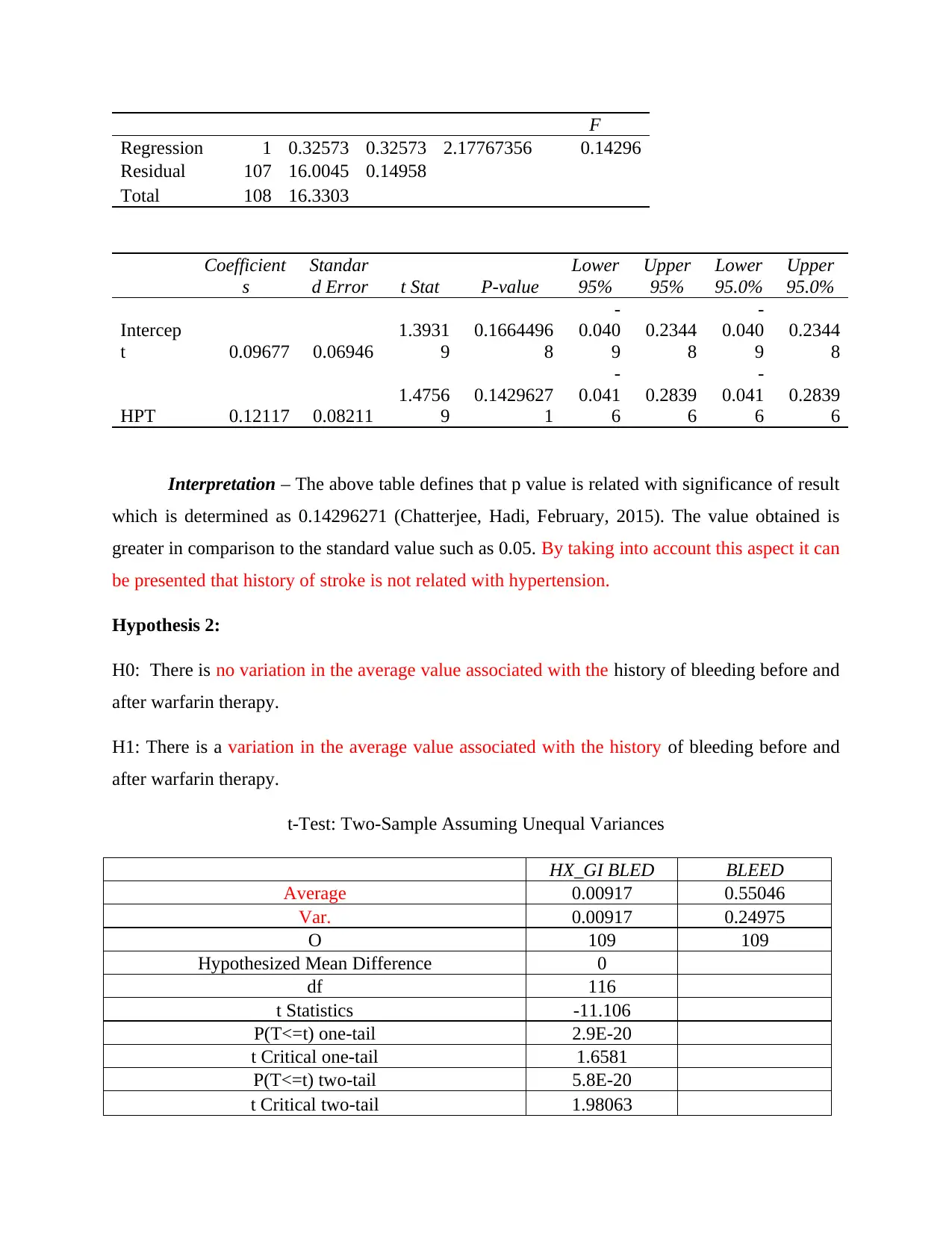
F
Regression 1 0.32573 0.32573 2.17767356 0.14296
Residual 107 16.0045 0.14958
Total 108 16.3303
Coefficient
s
Standar
d Error t Stat P-value
Lower
95%
Upper
95%
Lower
95.0%
Upper
95.0%
Intercep
t 0.09677 0.06946
1.3931
9
0.1664496
8
-
0.040
9
0.2344
8
-
0.040
9
0.2344
8
HPT 0.12117 0.08211
1.4756
9
0.1429627
1
-
0.041
6
0.2839
6
-
0.041
6
0.2839
6
Interpretation – The above table defines that p value is related with significance of result
which is determined as 0.14296271 (Chatterjee, Hadi, February, 2015). The value obtained is
greater in comparison to the standard value such as 0.05. By taking into account this aspect it can
be presented that history of stroke is not related with hypertension.
Hypothesis 2:
H0: There is no variation in the average value associated with the history of bleeding before and
after warfarin therapy.
H1: There is a variation in the average value associated with the history of bleeding before and
after warfarin therapy.
t-Test: Two-Sample Assuming Unequal Variances
HX_GI BLED BLEED
Average 0.00917 0.55046
Var. 0.00917 0.24975
O 109 109
Hypothesized Mean Difference 0
df 116
t Statistics -11.106
P(T<=t) one-tail 2.9E-20
t Critical one-tail 1.6581
P(T<=t) two-tail 5.8E-20
t Critical two-tail 1.98063
Regression 1 0.32573 0.32573 2.17767356 0.14296
Residual 107 16.0045 0.14958
Total 108 16.3303
Coefficient
s
Standar
d Error t Stat P-value
Lower
95%
Upper
95%
Lower
95.0%
Upper
95.0%
Intercep
t 0.09677 0.06946
1.3931
9
0.1664496
8
-
0.040
9
0.2344
8
-
0.040
9
0.2344
8
HPT 0.12117 0.08211
1.4756
9
0.1429627
1
-
0.041
6
0.2839
6
-
0.041
6
0.2839
6
Interpretation – The above table defines that p value is related with significance of result
which is determined as 0.14296271 (Chatterjee, Hadi, February, 2015). The value obtained is
greater in comparison to the standard value such as 0.05. By taking into account this aspect it can
be presented that history of stroke is not related with hypertension.
Hypothesis 2:
H0: There is no variation in the average value associated with the history of bleeding before and
after warfarin therapy.
H1: There is a variation in the average value associated with the history of bleeding before and
after warfarin therapy.
t-Test: Two-Sample Assuming Unequal Variances
HX_GI BLED BLEED
Average 0.00917 0.55046
Var. 0.00917 0.24975
O 109 109
Hypothesized Mean Difference 0
df 116
t Statistics -11.106
P(T<=t) one-tail 2.9E-20
t Critical one-tail 1.6581
P(T<=t) two-tail 5.8E-20
t Critical two-tail 1.98063
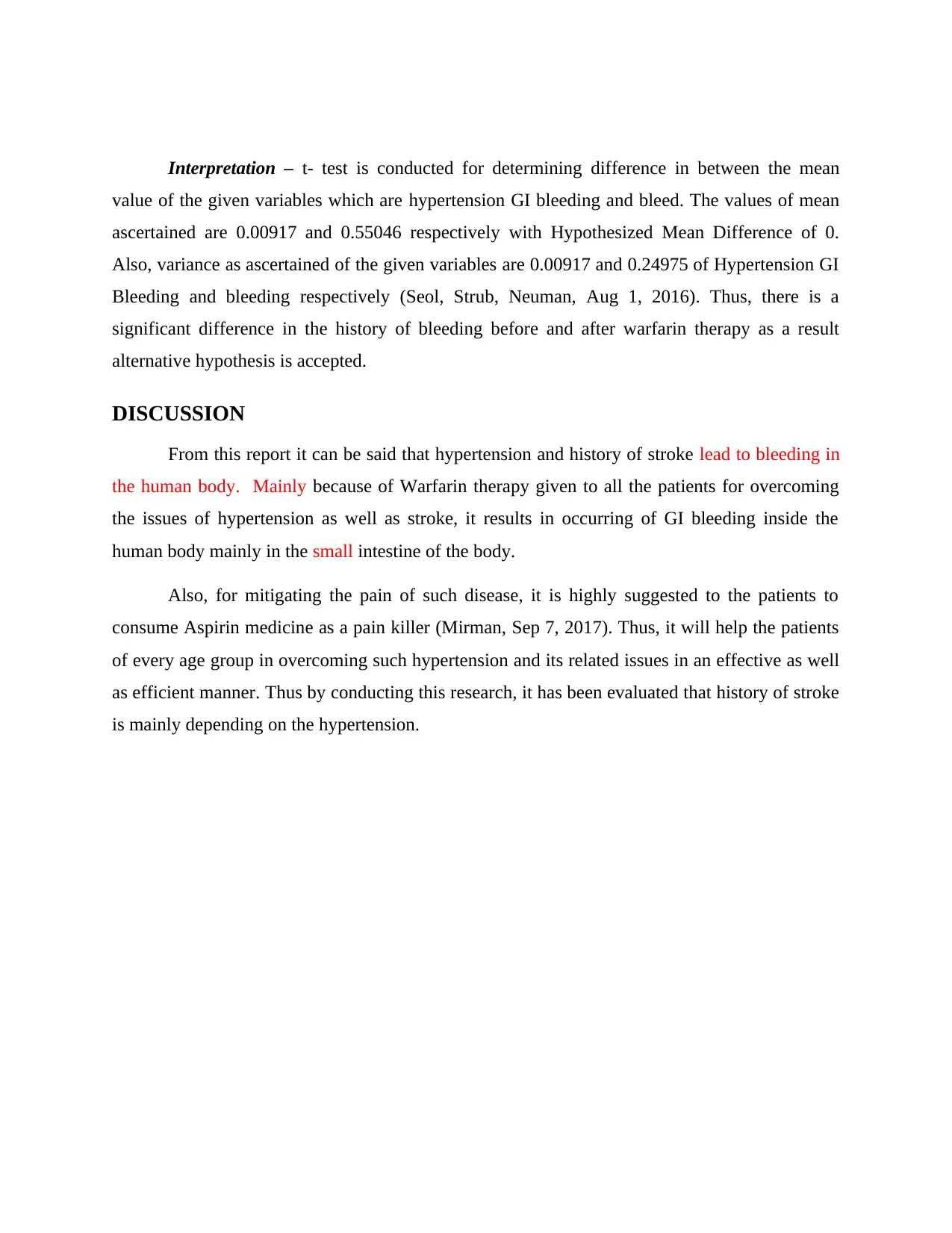
Interpretation – t- test is conducted for determining difference in between the mean
value of the given variables which are hypertension GI bleeding and bleed. The values of mean
ascertained are 0.00917 and 0.55046 respectively with Hypothesized Mean Difference of 0.
Also, variance as ascertained of the given variables are 0.00917 and 0.24975 of Hypertension GI
Bleeding and bleeding respectively (Seol, Strub, Neuman, Aug 1, 2016). Thus, there is a
significant difference in the history of bleeding before and after warfarin therapy as a result
alternative hypothesis is accepted.
DISCUSSION
From this report it can be said that hypertension and history of stroke lead to bleeding in
the human body. Mainly because of Warfarin therapy given to all the patients for overcoming
the issues of hypertension as well as stroke, it results in occurring of GI bleeding inside the
human body mainly in the small intestine of the body.
Also, for mitigating the pain of such disease, it is highly suggested to the patients to
consume Aspirin medicine as a pain killer (Mirman, Sep 7, 2017). Thus, it will help the patients
of every age group in overcoming such hypertension and its related issues in an effective as well
as efficient manner. Thus by conducting this research, it has been evaluated that history of stroke
is mainly depending on the hypertension.
value of the given variables which are hypertension GI bleeding and bleed. The values of mean
ascertained are 0.00917 and 0.55046 respectively with Hypothesized Mean Difference of 0.
Also, variance as ascertained of the given variables are 0.00917 and 0.24975 of Hypertension GI
Bleeding and bleeding respectively (Seol, Strub, Neuman, Aug 1, 2016). Thus, there is a
significant difference in the history of bleeding before and after warfarin therapy as a result
alternative hypothesis is accepted.
DISCUSSION
From this report it can be said that hypertension and history of stroke lead to bleeding in
the human body. Mainly because of Warfarin therapy given to all the patients for overcoming
the issues of hypertension as well as stroke, it results in occurring of GI bleeding inside the
human body mainly in the small intestine of the body.
Also, for mitigating the pain of such disease, it is highly suggested to the patients to
consume Aspirin medicine as a pain killer (Mirman, Sep 7, 2017). Thus, it will help the patients
of every age group in overcoming such hypertension and its related issues in an effective as well
as efficient manner. Thus by conducting this research, it has been evaluated that history of stroke
is mainly depending on the hypertension.
⊘ This is a preview!⊘
Do you want full access?
Subscribe today to unlock all pages.

Trusted by 1+ million students worldwide

CONCLUSION
From the above findings it can be concluded that with the help of regression and t -test,
data gathered has been interpreted. It has been assessed that as p value obtained for stroke and
hypertension is greater which has resulted in accepting of null hypothesis. Referring this, it can
be presented that hypertension and history of stroke are not statistically associated with each
other. And because of significant difference in between the mean value of the history of bleeding
before and after warfarin therapy alternative hypothesis is accepted.
From the above findings it can be concluded that with the help of regression and t -test,
data gathered has been interpreted. It has been assessed that as p value obtained for stroke and
hypertension is greater which has resulted in accepting of null hypothesis. Referring this, it can
be presented that hypertension and history of stroke are not statistically associated with each
other. And because of significant difference in between the mean value of the history of bleeding
before and after warfarin therapy alternative hypothesis is accepted.
Paraphrase This Document
Need a fresh take? Get an instant paraphrase of this document with our AI Paraphraser
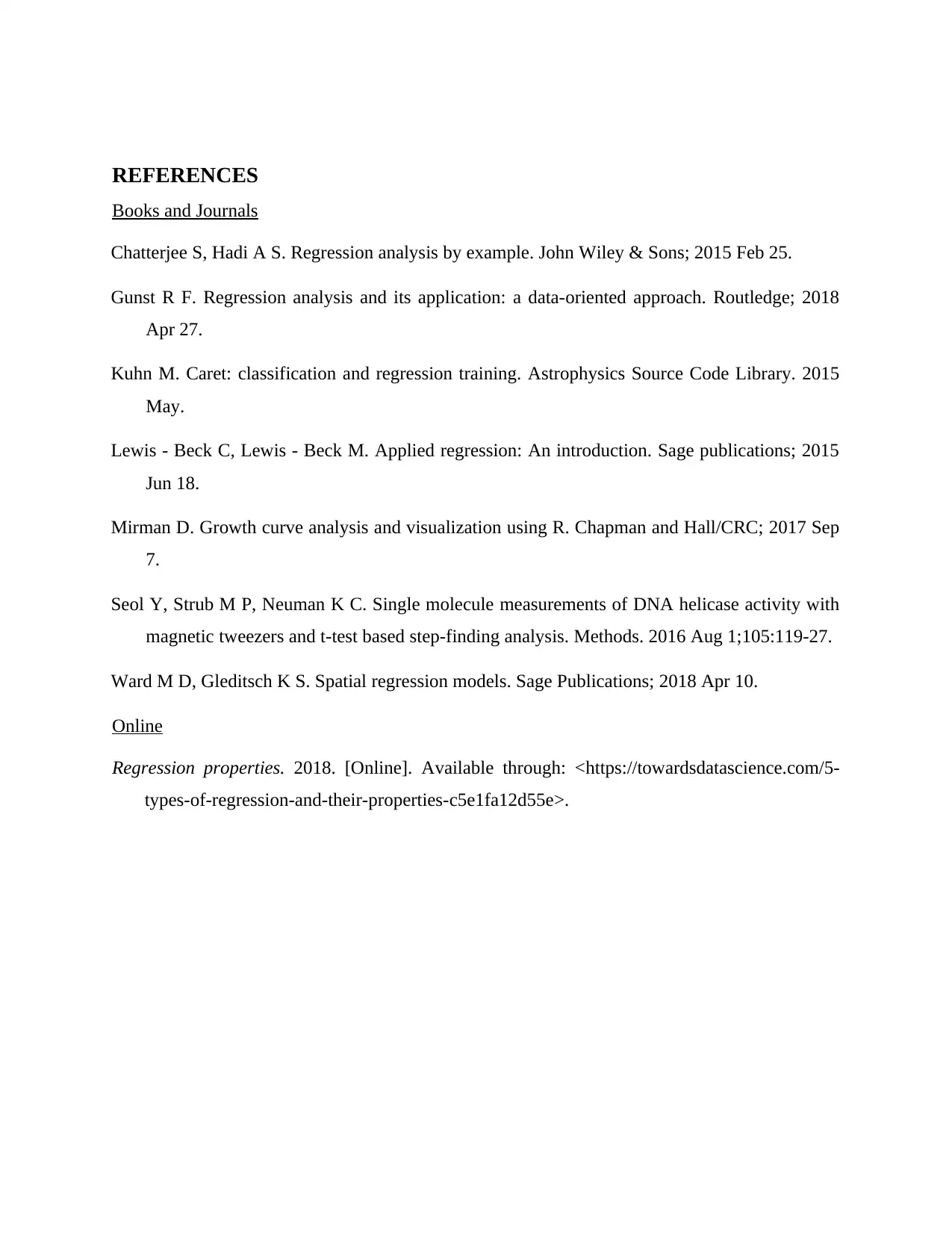
REFERENCES
Books and Journals
Chatterjee S, Hadi A S. Regression analysis by example. John Wiley & Sons; 2015 Feb 25.
Gunst R F. Regression analysis and its application: a data-oriented approach. Routledge; 2018
Apr 27.
Kuhn M. Caret: classification and regression training. Astrophysics Source Code Library. 2015
May.
Lewis - Beck C, Lewis - Beck M. Applied regression: An introduction. Sage publications; 2015
Jun 18.
Mirman D. Growth curve analysis and visualization using R. Chapman and Hall/CRC; 2017 Sep
7.
Seol Y, Strub M P, Neuman K C. Single molecule measurements of DNA helicase activity with
magnetic tweezers and t-test based step-finding analysis. Methods. 2016 Aug 1;105:119-27.
Ward M D, Gleditsch K S. Spatial regression models. Sage Publications; 2018 Apr 10.
Online
Regression properties. 2018. [Online]. Available through: <https://towardsdatascience.com/5-
types-of-regression-and-their-properties-c5e1fa12d55e>.
Books and Journals
Chatterjee S, Hadi A S. Regression analysis by example. John Wiley & Sons; 2015 Feb 25.
Gunst R F. Regression analysis and its application: a data-oriented approach. Routledge; 2018
Apr 27.
Kuhn M. Caret: classification and regression training. Astrophysics Source Code Library. 2015
May.
Lewis - Beck C, Lewis - Beck M. Applied regression: An introduction. Sage publications; 2015
Jun 18.
Mirman D. Growth curve analysis and visualization using R. Chapman and Hall/CRC; 2017 Sep
7.
Seol Y, Strub M P, Neuman K C. Single molecule measurements of DNA helicase activity with
magnetic tweezers and t-test based step-finding analysis. Methods. 2016 Aug 1;105:119-27.
Ward M D, Gleditsch K S. Spatial regression models. Sage Publications; 2018 Apr 10.
Online
Regression properties. 2018. [Online]. Available through: <https://towardsdatascience.com/5-
types-of-regression-and-their-properties-c5e1fa12d55e>.
1 out of 8
Related Documents
Your All-in-One AI-Powered Toolkit for Academic Success.
+13062052269
info@desklib.com
Available 24*7 on WhatsApp / Email
![[object Object]](/_next/static/media/star-bottom.7253800d.svg)
Unlock your academic potential
Copyright © 2020–2025 A2Z Services. All Rights Reserved. Developed and managed by ZUCOL.





